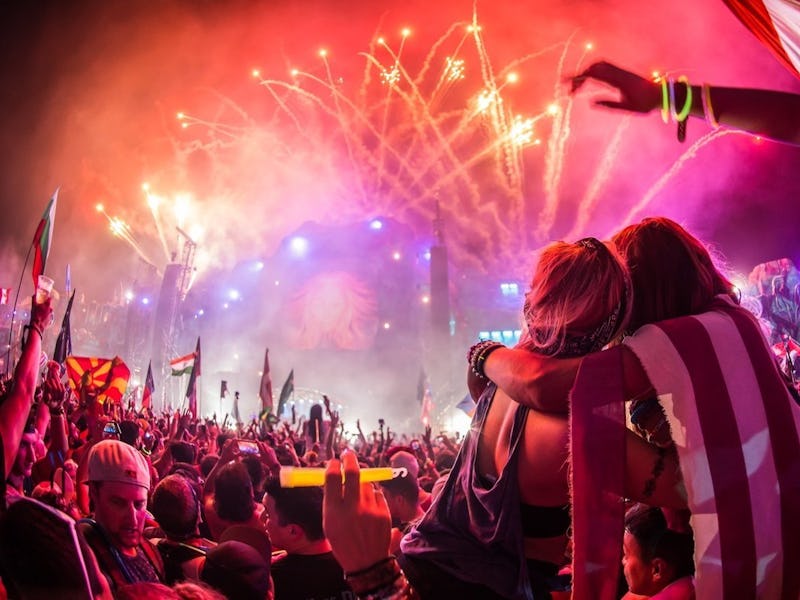The Scientific Way to Create a Music Festival Drug Schedule
Plan ahead to avoid a visit to the chillout tent.

Each year, attendees at overnight festivals like Electric Forest, Firefly, and Lightning in a Bottle consume nose loads of powders and mouthfuls of pills, but as they drift away on waves of dopamine, they don’t always have the presence of mind to consider pacing. Which, of course, can have disastrous effects. Kristin Karas, the Visionaries Program coordinator of DanceSafe, an organization dedicated to safety in the electronic music community, says this is what keeps the chillout tent packed. People don’t have a drug schedule because they think drugs should be spur-of-the-moment fun. Sure, that makes sense if you’re heading to a one-night-only Zedd gig, but not if you’re headed to Bonnaroo.
While drug taking at festivals will always be too risky to be considered safe, Karas explains, there are ways to make it less dangerous overall. “The whole concept is harm reduction’,” she tells Inverse. Here’s what not to do on your multi-day trip.
Don’t Mix Stimulants and Depressants
“You would want to keep in mind mixing depressants with other stimulants,” says Karas. For example, consuming alcohol (a depressant) with cocaine (a stimulant), she explains, is one of the most common mistakes made at festivals. When these two drugs are taken together, they react to produce a metabolite called cocaethylene, which can build up in a person’s system, sometimes with fatal results.
Amphetamines are another common stimulant class that tends to get mixed in with alcohol. Case in point: Adderall is often washed down with booze by people looking to stay up and party. Unfortunately, Adderall’s inebriation-dulling effects disguise the symptoms of alcohol poisoning. “Because it’s a prescription drug, sometimes people don’t necessarily think about what the combination is,” Karas says.
These, of course, aren’t the only dangerous pairings. The outcome of pretty much every drug combination under the sun is mapped out in the drug combination chart developed by TripSit, which Karas recommends checking out. While the information isn’t definitive — the data is completely crowdsourced, and it’s constantly being updated — it’s a good place to start research before deciding to stack at a festival.
TripSits guide to drug combinations lists low-risk, high-risk, and synergistic pairings alike.
Don’t Get High Before Bed
After a long day spent turning up at a music festival, it often isn’t easy to turn down. “People will consume MDMA and at the end of the night will have difficulty sleeping, so they’ll try to use a depressant such as an opiate or a benzodiazapine,” Karas says. Unfortunately, the cost of a good night’s sleep at a festival is often pretty steep; the MDMA-benzodiazepine combination, for example, puts a lot of stress on the heart and other bodily functions.
Don’t Stack Hits of MDMA
“We caution against the stacking of MDMA use,” Karas says, explaining that the drug’s potency decreases vastly if it’s taken twice within a weekend. Increasing the dose to compensate won’t get you any more high, either; it simply “increases the danger drastically.” In other words, taking multiple hits to get high within a short span of time is somewhat of a futile endeavor.
So how much time should users leave between doses? In a follow-up e-mail, DanceSafe’s National Outreach Director, Mitchell Gomez, told Inverse that the dearth of research into MDMA use means there’s no definitive answer. “The general rule of thumb that many people use is three months between usage,” he said, “Although I know several people involved in the medical field, who, in their personal use, try to always wait a year.”
He points out that the few studies carried out by MAPS on the use of MDMA in patients with post-traumatic stress disorder administer several doses in a relatively short period of time, but it’s important to interpret these studies carefully. “Obviously, extrapolating from a medical setting with laboratory produced MDMA to field usage of ‘whatever was sold as molly’ is dicey at best,” he says, “But it is a data point worth keeping in mind.”
Don’t Double Down on Psychedelics
Spacing out doses of psychedelics is, simply put, more economical. “It’s important to note that LSD and mushrooms have cross-tolerance,” Karas says. “Taking one the day after taking the other will result in a more subtle effect on the second day.”
Don’t Take MDMA Without Supplements (Unless You Don’t Have Supplements)
People accustomed to MDMA use often take doses of 5-HTP after rolling; the compound is a precursor to serotonin and is thought to help replenish stores of the happy-making neurotransmitter after they’re depleted during a trip. But taking it while on MDMA, Gomez says, “might cause some fairly serious complications.”
Studies have shown that taking R-alpha-lipoic acid — a powerful antioxidant — has been shown to reduce MDMA neurotoxicity, he adds. And those who tend to clench their jaws while rolling might also want to bring along magnesium supplements to take before and after an MDMA experience, as many users have reported their mitigating effects.
Still, Gomez points out, he can only suggest these points as guidelines. Scientifically speaking, we simply don’t know that much about drugs. “If the federal government put 1% of the money we spend arresting drug users into studying how to mitigate the risks of drug use,” he says, “we would know all of these things definitively.”